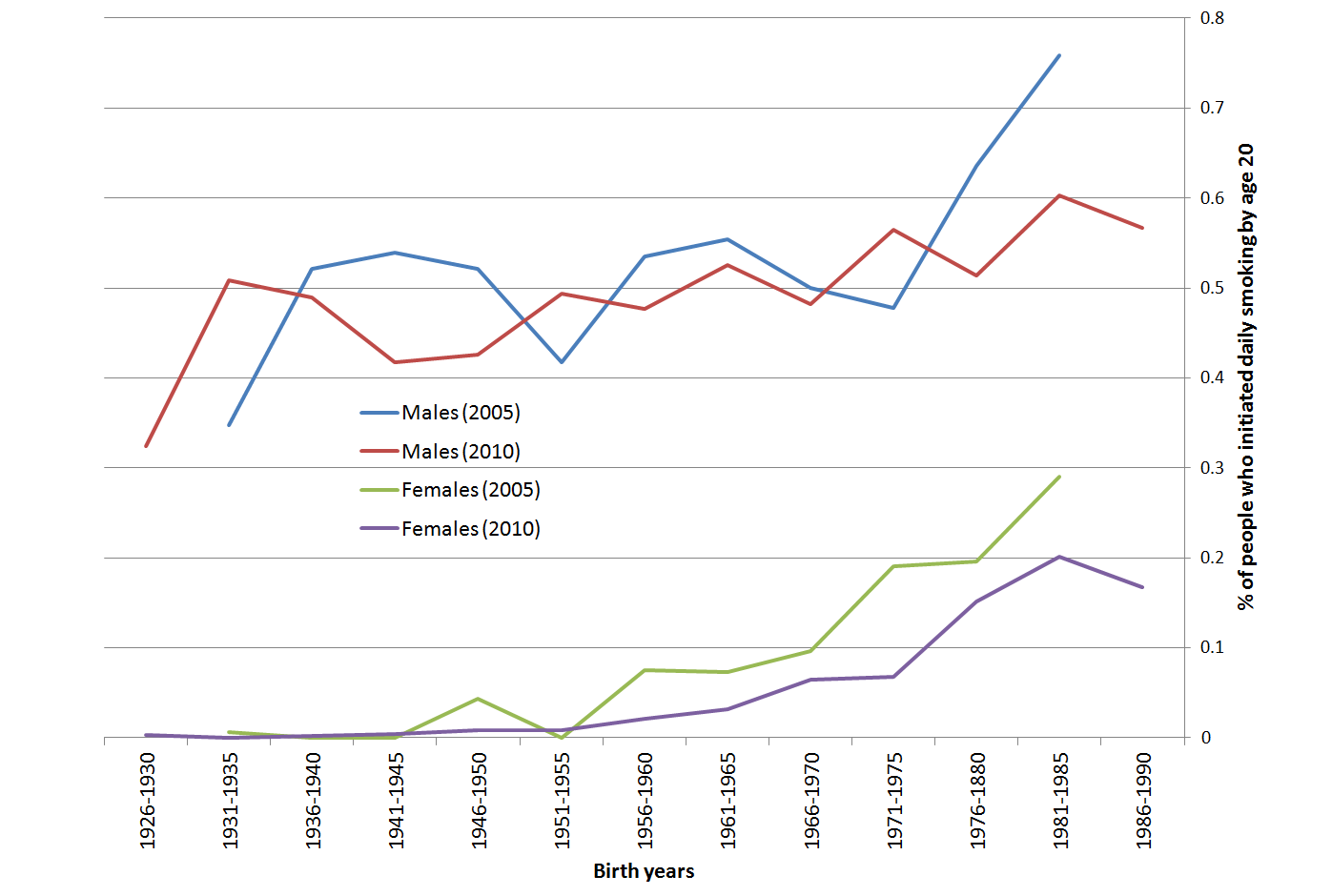Recent manuscripts
Archive
Editorial Board
Aims and Scope
Open Access
Indexing
Contact us
Authorship & COI
Principles of Transparency Checklist
Publication Ethics
Crossmark
Data Policies
Supporting Diversity
Instructions to authors (PDF)
Manuscript Types
Manuscript Formatting
How to submit
Special Publications & Reprints
Preprints
Monitoring initiation of daily smoking as an indicator of tobacco control success: example of Ukraine
1
Babeș-Bolyai University, Department of Public Health, Ukraine
Publication date: 2018-03-01
Tob. Induc. Dis. 2018;16(Suppl 1):A588
KEYWORDS
TOPICS
ABSTRACT
Background:
While tobacco control measures aim to both prevent smoking initiation and facilitate quitting smoking, these processes do not always occur in parallel. While the prevalence of daily smoking declined in Ukraine from 37% in 2005 to less than 25% more recently, it changes among young people much more clearly than among older groups. We explore approaches to consider data on smoking initiation.
Methods:
Initiation of daily smoking was analyzed across 5-year birth cohorts among the participants of two nationally representative surveys conducted in Ukraine in 2005 and 2010. The proportion of men and women who initiated daily smoking before age 20 was compared across genders and birth cohorts.
Results:
Among men, about 50% were becoming daily smokers by age 20 since the 1950s. Among women, daily smoking remained negligible till about 1970s. From the 1990s, an increase in initiation of smoking became obvious among both genders and reached 70% of men and 20% of women initiating smoking by 20 years of age. However, after first tobacco control measures have been launched in Ukraine since 2005, youngest cohorts demonstrated reduced smoking initiation. Still, responses of older cohorts in men were consistent with data from earlier survey while women tended to underreport their past smoking initiation.

[Initiation of daily smoking by age 20 in Ukraine]
Conclusions:
Smoking initiation data can reliably be collected from survey participants including that from older birth cohorts. The level of smoking initiation reflects both the periods when the tobacco industry was booming and the successes of tobacco control. Reduction in smoking initiation becomes an earlier outcome of tobacco control than stopping smoking and accumulation of former smokers.
While tobacco control measures aim to both prevent smoking initiation and facilitate quitting smoking, these processes do not always occur in parallel. While the prevalence of daily smoking declined in Ukraine from 37% in 2005 to less than 25% more recently, it changes among young people much more clearly than among older groups. We explore approaches to consider data on smoking initiation.
Methods:
Initiation of daily smoking was analyzed across 5-year birth cohorts among the participants of two nationally representative surveys conducted in Ukraine in 2005 and 2010. The proportion of men and women who initiated daily smoking before age 20 was compared across genders and birth cohorts.
Results:
Among men, about 50% were becoming daily smokers by age 20 since the 1950s. Among women, daily smoking remained negligible till about 1970s. From the 1990s, an increase in initiation of smoking became obvious among both genders and reached 70% of men and 20% of women initiating smoking by 20 years of age. However, after first tobacco control measures have been launched in Ukraine since 2005, youngest cohorts demonstrated reduced smoking initiation. Still, responses of older cohorts in men were consistent with data from earlier survey while women tended to underreport their past smoking initiation.

[Initiation of daily smoking by age 20 in Ukraine]
Conclusions:
Smoking initiation data can reliably be collected from survey participants including that from older birth cohorts. The level of smoking initiation reflects both the periods when the tobacco industry was booming and the successes of tobacco control. Reduction in smoking initiation becomes an earlier outcome of tobacco control than stopping smoking and accumulation of former smokers.
CITATIONS (1):
1.
Prevalence of Smoking Various Tobacco Types in the Kazakhstani Adult Population in 2021: A Cross-Sectional Study
Natalya Glushkova, Dariga Smailova, Zhanar Namazbayeva, Gulmira Mukasheva, Ayaulym Zhamakurova, Asylzhan Kuanyshkalieva, Indira Karibayeva, Almagul Kauysheva, Nurzhamal Otyzbayeva, Maksut Kulzhanov, Yuliya Semenova
International Journal of Environmental Research and Public Health
Natalya Glushkova, Dariga Smailova, Zhanar Namazbayeva, Gulmira Mukasheva, Ayaulym Zhamakurova, Asylzhan Kuanyshkalieva, Indira Karibayeva, Almagul Kauysheva, Nurzhamal Otyzbayeva, Maksut Kulzhanov, Yuliya Semenova
International Journal of Environmental Research and Public Health
Share
RELATED ARTICLE
We process personal data collected when visiting the website. The function of obtaining information about users and their behavior is carried out by voluntarily entered information in forms and saving cookies in end devices. Data, including cookies, are used to provide services, improve the user experience and to analyze the traffic in accordance with the Privacy policy. Data are also collected and processed by Google Analytics tool (more).
You can change cookies settings in your browser. Restricted use of cookies in the browser configuration may affect some functionalities of the website.
You can change cookies settings in your browser. Restricted use of cookies in the browser configuration may affect some functionalities of the website.

